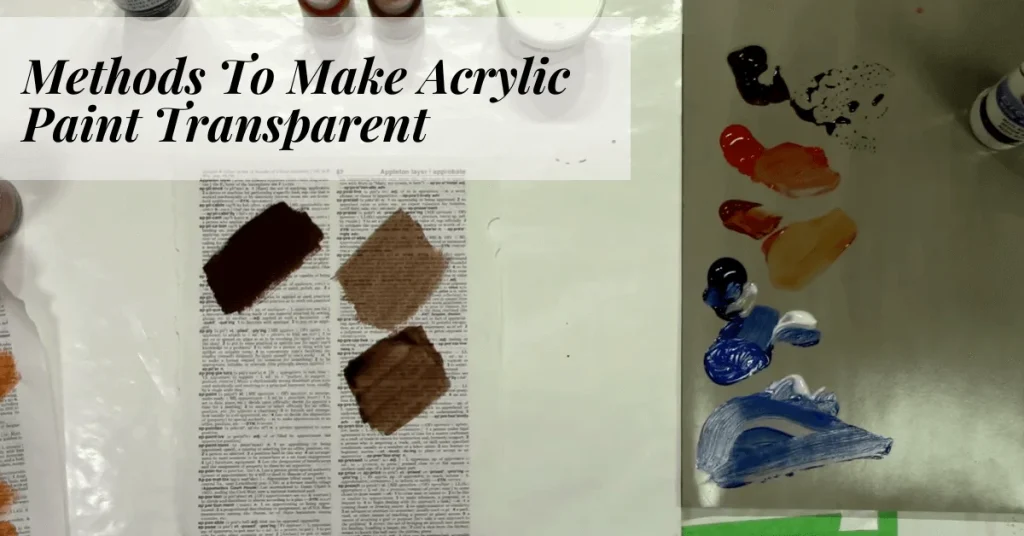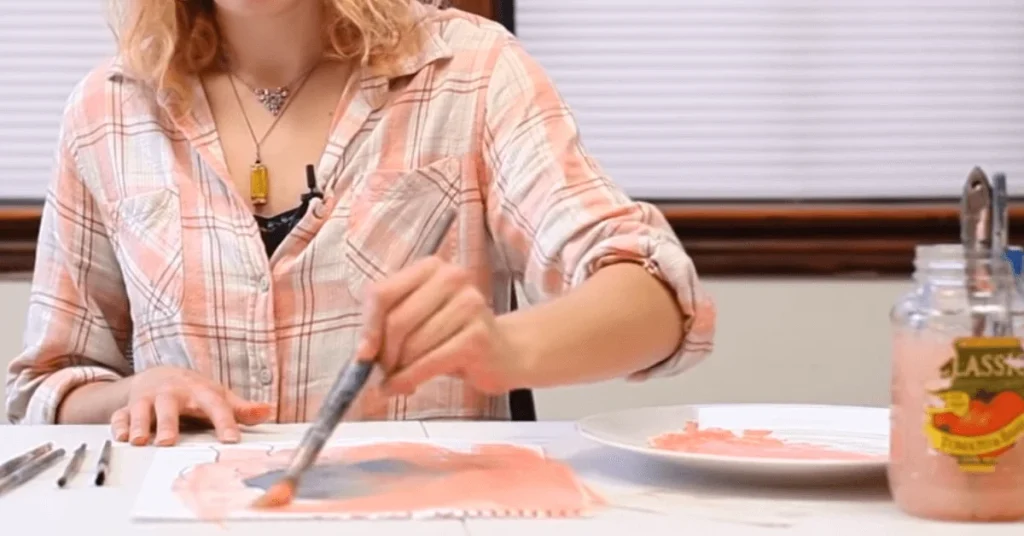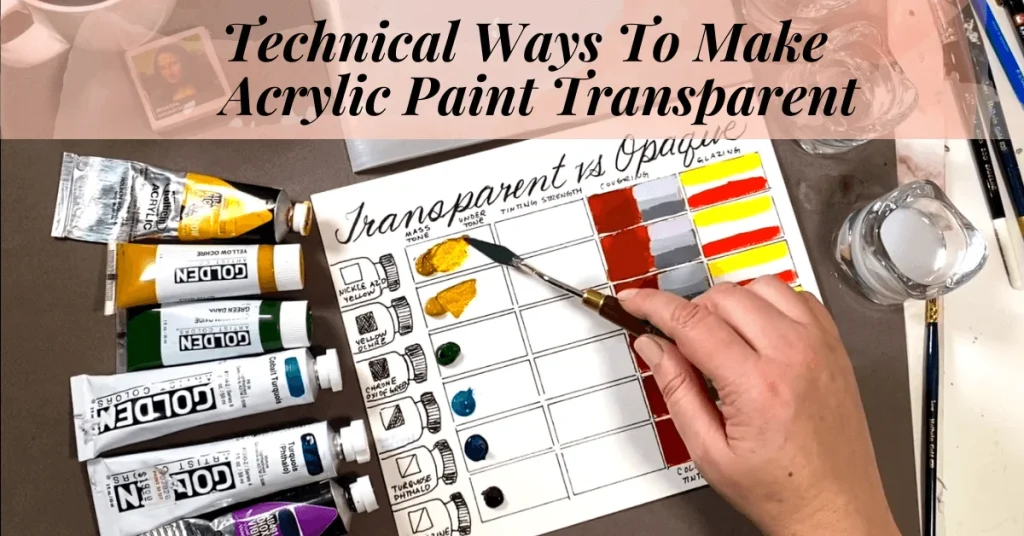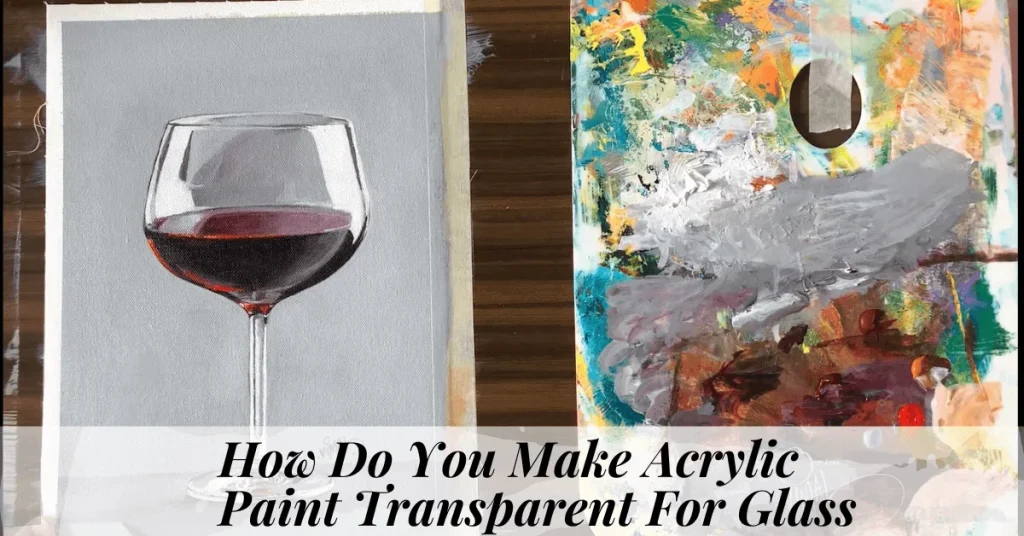Transparent paint refers to paint that allows the surface underneath to be visible. It is generally used for glazing, layering, clear finish, and protective layering in art and painting.
If you’re looking to build up depth and complexity in your work or want to achieve a more subtle or luminous effect in your acrylic painting art, you’ll need translucent paint. But how to make acrylic paint transparent?
Well, the best way to get acrylic paint transparent is by adding acrylic mediums. There are some technical ways, too, like thin layering, scraping, and using less pigmented paints. Water can also be used as an affordable alternative to these methods.
I was really impressed by Alex Katz (a famous figurative artist) during a meeting at a Charity Art School. He made me realize how well scraping techniques be effective in producing various translucent and abstract effects.
In the post below, I’ll discuss all the possible ways and techniques to make acrylic paint transparent. I’ll teach you how to make these methods effective, affordable, and reliable for your artwork. So keep reading.
Methods To Make Acrylic Paint Transparent
There are multiple strategies to acquire transparent acrylic paints. I’ve applied the following ways many times and found them really working for me; hence I’m sharing some of the best transparent acrylic painting techniques with you.

- Add Glazing Medium
Acrylic glazing is a transparent acrylic medium and is one of the excellent ways to get your paint translucent. It doesn’t disturb the consistency of the paint too much. Here is how to make acrylic paint translucent with a liquid glazing medium.
Add the medium in the paint in a ratio of about one part glazing medium to three parts acrylic paint. Stir the mix thoroughly, and then apply the mixture to the surface you want to paint.
Keep in mind that adding more glazing medium gonna make the paint more translucent, but the downside is it will also make the paint more fluid and difficult to manage and control.
So I suggest you maintain and adjust the proportion of the medium to paint as per your requirements to attain the desired level of transparency.
- Add Water Based Varnish
Another effective way of achieving transparency in your acrylic paint is adding a varnish. It is almost the same as a glazing medium but different in composition and properties. Varnishes are available in both types, whether you want a shiny surface or give acrylic paint a matte appearance.
To make acrylic paint transparent with varnish, you have to mix a gloss varnish with the paint in a 1:3 ratio of varnish to paint. Start by mixing a minute quantity of varnish with the paint, and gradually add more until you acquire the level of transparency you want.
Don’t exceed the above ratio, as adding too much gonna ruin the paint. Make sure you use the same type of varnish as the acrylic paint, i.e., water-based.
- Add Acrylic Flow Improver
What is an acrylic flow improver? It is a type of additive that is used in paint formulations to improve the flow and balancing properties of the paint. It is generally used in latex and water-based paints. It helps to reduce the impression of brush and roller marks, resulting in a smoother and even finish.
Adding acrylic flow makes the paint transparent. You can begin by adding 10% of the product to the paint and then increasing the amount slowly until you reach the desired effect.
- Add Paint Thinner
What is a paint thinner? It is a medium that contains resin and solvent only. When added, it thins down or brings fluidity to the paint without disrupting the consistency of the paint.
How does paint thinner help in making acrylic paint transparent? Well, the answer is technical. The medium increases the volume of the paint against the pigment. Moreover, thinning makes the paint more transparent when applied to any surface.
Start with mixing a small quantity and proceed with the instructions written on the label. Avoid using poor-quality products, and ensure you use acrylic-based thinners.

- Add Acrylic Extender
What do you mean by acrylic extender? It is a type of paint additive that is added to acrylic paint to increase its volume, decrease its cost, and enhance its performance. Acrylic extenders are commonly composed of ground minerals or sometimes synthetic polymers.
They can be added to acrylic paint in an appropriate amount to achieve desired impacts. They can also be used to increase the translucency of the paint, which can be helpful for producing glazes and for building up layers of paint with a gradual transition of shades.
I usually mix one part of the extender with five parts of the paint as my necessities vary during abstract art. However, you can increase the quantity according to your preference.
- Use Transparent Acrylic Ink
Transparent acrylic ink is a type of ink that is synthesised with a combination of acrylic polymer emulsion and pigments. It is known for its transparent marks. In addition, it is durable and water resistant.
If you ever get a chance to meet me, you’ll definitely see a glance of this ink in my artwork. It doesn’t need much preparation. Just buy and use it.
It is helpful in a variety of applications, including screen printing, handwriting, and mixing acrylic paint for airbrushing. Moreover, being water-based, it is easy to clean up and does not have toxic or strong fumes.
- Add Floetrol
What do you mean by floetrol? It is a paint conditioner that can be added to acrylic paint to improve the flow of the paint and reduce irregular flecks by brush.
It is also used as a medium in acrylic pouring painting. The product enhances the liquid nature of the paint, making it a good source of acquiring transparent formation.
- Dilution With Water
Can you make acrylic paint transparent with water? Yes, it is an affordable yet effective way to make acrylic paint transparent. It decreases the viscosity of the paint, making it appear more translucent.
Make sure you don’t mix more than 30% of water, as it can alter the composition and the base of the paint. Adding too much water may reduce the sticky nature of the paint too.
Always use distilled and clean water and use a dropper so that you control and manage the quantity of water you add to the paint. Mix the solution vigorously.
Learn more: Is acrylic paint water soluble?
Technical Ways To Make Acrylic Paint Transparent
Are you not willing to add any medium or material to the paint? No worries, there are some technical ways to get the paint transparent. Although these techniques are challenging, even a beginner can do them. Here is a list of how to make acrylic transparent.

- Thin Layering
If you want to build up a glassy appearance or are willing to add some acrylic painting transparent coats to your art, use the paint in thin layering. The slimmer the coat, the lesser the pigment; ultimately, you get a transparent appearance.
Thick layers produce an opaque effect due to a higher amount of pigment. Another advantage of thin layering is you don’t get cracks or chips in your artwork; the paint dries quickly and adheres better.
You may also learn: How to thin acrylic paint?
- Use Thinner Brush
A more convenient and manageable technique to get clear acrylic paint upshots on your surface is by using a thinner brush.
It can be used to create a gauzy effect in art by allowing more of the underlying coatings to show through. This can be accomplished by using a brush with a tinier diameter or by adjusting the brush’s opacity. You may also use a brush with a softer edge to acquire transparency.
- Use Palette Knife or Spatula
Generally, a palette knife is used to mix and apply paint to a surface. Its flat and adjustable blade can also be employed to create impasto effects by applying dense layers of paint.
But how to use a palette knife for acrylic paint transparency? When using a palette knife for translucent acrylic painting, you can control the amount of paint to be applied and the degree of transparency by manipulating the angle and pressure of the knife.
The more the angle of the knife is curved or towards 90 degrees, the more transparency you get. The science behind it is simple; curved angles produce thin layers.
The palette knife can also be used to create unusual textures and patterns, making it a remarkable tool in the creation of versatile artwork.
- Scrapping Techniques
Another technical way is by scrapping the paint when it is dried. It requires focus and practice but can provide you with excellent outcomes and able you to discover new procedures of painting.
Apply thick layers of acrylic paint in the first step and wait for drying. Now, with the help of a palette knife or scraper, carefully scrape off some of the paint to reveal the underlying surface and make the paint appear transparent.
Make sure you scrape only those locations or areas on your canvas that you want to be transparent. With this technique, I’ve learned unique and distinct ways of producing impressive effects.
How To Make Acrylic Paint Transparent For Glass?
The glass surface is quite smooth and non-porous, making it difficult for acrylic paint to stick to. Hence, we usually use a primer and sanding paper to adhere the paint to the glass.
In case If you want to make acrylic paint transparent for glass, you have to follow the instructions below:
- Use a clear acrylic primer to make the paint stay on the surface as well as look transparent.
- Start with light layers of paint.
- Dilute the paint with moisture or a glazing medium specifically made for glass surfaces.
- Add a final protective layer of varnish for added durability.

Also read: How to paint with acrylic on canvas?
List of Transparent Acrylic Paints
I’ve mentioned some popular brands of transparent acrylic paint below. Some colors within these lines may be more transparent than others.
Also keep in mind that although these paints may be labeled as “transparent,” but still they have some opacity to them depending on the thickness of the application and the surface they’re applied to. Here is the list, all of them have transparent color versions.
• Golden Fluid Acrylics
• Liquitex Professional Acrylic Transparent Colors
• Winsor & Newton
• Daler Rowney System 3
• Amsterdam Acrylic Ink
• M. Graham & Co. Acrylics Transparent Colors
• Holbein Acrylic Ink
• Sennelier Abstract
• Arteza
• Chroma Atelier Interactive
FAQs
What medium makes the acrylic paint more transparent?
Glazing medium is the ideal choice for getting desired transparency in acrylic painting. Moreover, a gloss medium also puts on promising results.
How do you change the transparency of acrylic paint?
Changing acrylic paint transparency can be brought up in two ways. Either you add mediums, water, or fluids in the paint or use technical expertise to scrape and thin the painting.
How do you make clear acrylic?
To make acrylic paint clear, you’ll need to mix it with paint thinner, gloss medium, or dilute it with non-pigmented products.
How to paint something to look transparent?
You can paint a surface in thin layering or add some transparent mediums to lighten its color and make it appear translucent.
Why is my acrylic paint transparent?
Your acrylic may appear transparent due to various reasons. Different brands have different acrylic paint opacity and quality. Moreover, you may have added too much water or applied very thinner layers.
Final Thoughts
So how to make acrylic paint transparent? Well, the transparency of acrylic paint can be altered by putting in mediums, adjusting the pigment concentration, and layering the paint. But how to do so requires guidance, and I believe I’ve delivered all the necessary information.
The final conclusion is that acrylic paint has a level of transparency that can be adjusted to suit the desired effect for a certain painting.
Thank You For Reading!
- How To Buff Acrylic Enamel Paint In 5 Easy Steps? - February 2, 2024
- How To Make Acrylic Paint More Opaque? 10 Effective Methods - February 1, 2024
- How To Sketch On Canvas Before Acrylic Painting? Draw Like a Pro - January 31, 2024

